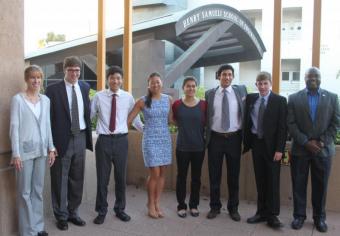St. Margaret’s High School Students Gain University-level Research Experience during Summer Internships at Samueli School
 Six students participated in this year’s St. Margaret’s Episcopal High School Summer Internship Program at the Samueli School of Engineering,
Six students participated in this year’s St. Margaret’s Episcopal High School Summer Internship Program at the Samueli School of Engineering,
Now in its ninth year, the internship program matches high school students, based on their interests, with a faculty member and research area. Initiated by Engineering Leadership Council member Stacey Nicholas, who has an interest and passion in increasing the number of students entering science and engineering fields, the program accepts five to 10 students each summer. Admission is competitive and based on students’ GPA and academic merits. Students receive university credit, which they can add to their college applications.
“Our students are fortunate to be able to participate in these engineering internships,” says Jennifer Ross-Viola, St. Margaret’s School science department chairperson. “Through this opportunity, students gain an understanding of what collegiate-level engineering research really is and how much time and energy goes into making even small advances in that field. In addition to the content they learn with regard to their projects, all of the students developed some proficiency with a variety of computer programming languages or specialized engineering software. We’d like to thank Dean Washington and the Samueli School of Engineering for continuing to support this remarkable program.”
The high school students recently presented their research projects to their parents, teachers and the engineering faculty and graduate students who mentored them at an event hosted by Samueli School Dean Gregory Washington.
Here are this year’s student projects:
Lara Ohanesian worked with Professor David Reinkensmeyer to create a virtual tour of the E-Health lab. The tour guides visitors through the lab process in an attempt to motivate them to learn more.
Matthew Price created and tested a cell stretcher to mechanically put stress on cells so that they could mature faster and promote healing. He worked with biomedical engineering professors Anna Grosberg and Wendy Liu.
Philip Bauer’s project, “Jammer Crutch Experiment,” involved testing an improvised crutch on a variety of surfaces and analyzing data in order to improve rehabilitation efforts. He worked with Reinkensmeyer.
Kian Shakerin worked with UC Irvine Distinguished Professor Satya Atluri to research structural mechanics and electrostatics and model both using COSMOL multi-physics software.
In her project titled “Lasers, Flames and Aerosols,” Tessa Hurr studied the use of thermocouples as a way to measure temperature in a variety of settings. Professor Derek Dunn-Rankin mentored Hurr.
In the lab of Professor Reinkensmeyer, Aaron Ko compared calibrator and manumeter data using Python software to measure joint movement in rehabilitation patients. A manometer is a wearable device consisting of a wrist-watch unit and a magnetic ring worn on the finger that senses how much a stroke patient is using his or her hand.
